The weekend of the 2019 Houston Marathon, Maura Linde reviewed the course map for a final time — not to make sure she had every turn, hill, and water station memorized, but rather to scope out the medical aid stations so she could drop out with people nearby.
“I really did think I wasn’t going to finish it,” she said.
Just five days before the race, she had caught a stomach virus that had torn through the cross country athletes she coached at Johns Hopkins University. She was aiming to run under 2:45 to qualify for the Olympic Marathon Trials, but she and her coach, Jerry Alexander of the Georgetown Running Club, almost pulled the plug.
“I couldn’t eat real food till a couple days before,” Linde recalled, saying she instead focused on staying hydrated. “I didn’t run again till the Friday before for a shake out.”
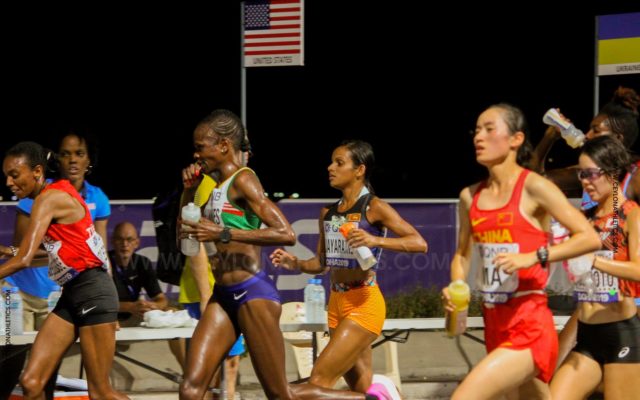
When Hiruni Wijayaratne toed the start line of the women’s marathon at the IAAF World Championships in Athletics in Doha, Qatar, it was just before midnight, but the heat and humidity were almost unbearable.
Had it been any other race it may have been a reason for a DNS. But Wijayaratne — a Herndon alumna now running for her native Sri Lanka — knew Doha was part of her path to the Olympics, a goal she had set her sights on back in 2016. She had to try.
Wijayaratne said she knew from the moment she landed in Qatar that it was going to be a tougher race than she, or anyone else, had expected. Read More
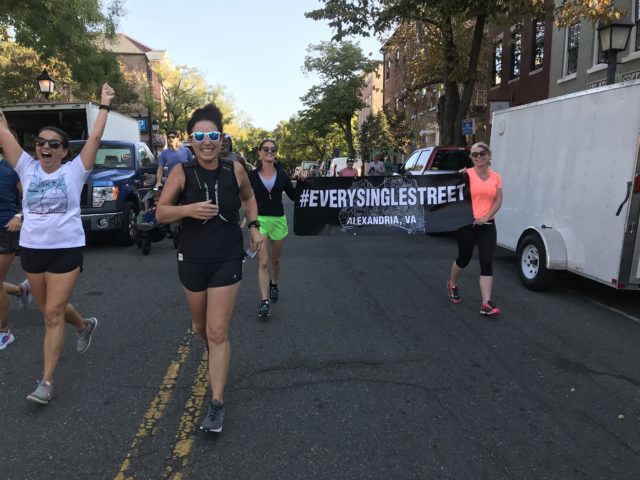
If you happened to be at the Old Town Farmers’ Market or one of the first to be strolling down King Street at the annual art festival last Saturday, you may have seen a small, spirited group celebrating a milestone occasion unbeknown to anyone but them.
Stephanie Lasure, the Alexandria woman who earlier this year set out to run every single street in the City of Alexandria, ran the last mile in the 330-mile journey that has taken her through every inch of the place she calls home.
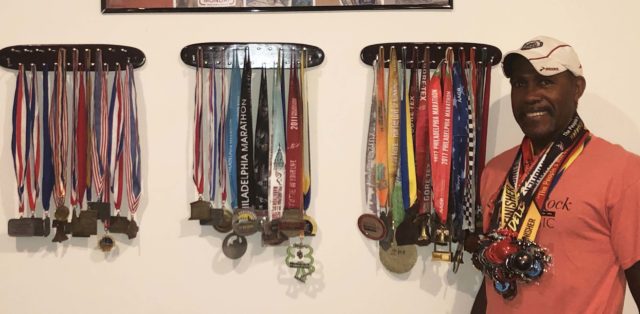
When Arthur Scott celebrates his 60th birthday on Oct. 7, he’ll be gearing up to mark another milestone — his 25th consecutive Marine Corps Marathon.
The Washingtonian native, who now lives in Charlotte, has run every Marine Corps Marathon since 1995, despite vowing never to run a marathon, then to run only one, then to stop after his 20th… you get the idea.
“Like many things, it was not planned,” Scott said.
The makings of Scott’s impressive run streak started in 1993, when a colleague planned to run the Marine Corps Marathon, but only to mile 20. He asked Scott to join him at the 13th mile to help get him through the last leg of the run.
“I said, ‘Sure, I’ll be there,'” recalled Scott, who already had been running consecutive Cherry Blossom Ten Mile races since the mid-80s. “I ran with him to 20 and in the excitement of the race he said, ‘I think I want to finish this.’ So, I said, ‘Well, if you’ve come this far and you want to try to finish it, I’ll stick with you.'”
What Scott saw at the finish line, shook him to his core.
“I had never been to the finish line at a marathon, and it was the worst thing I’ve ever seen,” Scott said. “I saw people getting sick. I saw one person faint. I saw people draped over other people. I saw toenails bleeding. I saw nipples bleeding. And I thought to myself ‘This is crazy.'”
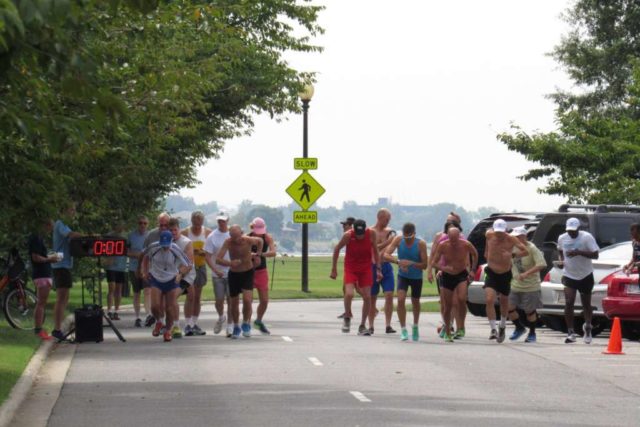
It may be older than the Marine Corps Marathon, but the Tidal Basin Runs might be the best kept secret in Washington’s running community — and its tight-knit group of members seems to like it that way.
Every month since April 1974, the club has met for what can only be described as the most covert race you’ve probably never seen or heard of. Yet the meticulously kept race results date back over 15 years and some runners have been participating for over 30.
There’s no entry fee (other than the club’s $10 annual membership fee), no bibs, no timing chips or race clock, no awards, and no commemorative t-shirts. In fact, there’s barely a start line — just a faint white line drawn across Ohio Drive SW that’s been slowly erased over the years by the elements and countless runners, cyclists, and vehicles that have made their way around the tip of Hains Point.
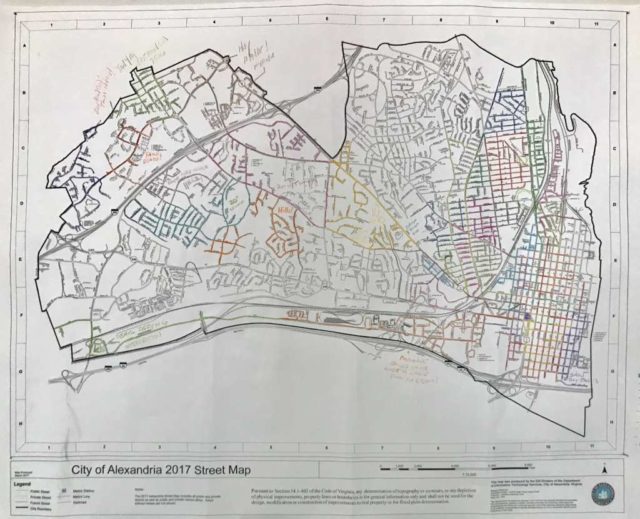
For the last 19 weeks, Stephanie Lasure has been running every street in the City of Alexandria. She is weaving her way through every nook and cranny — down every block in Old Town, around every cul-de-sac in Seminary Hill and up every ascent in Rosemont.
Over 151,000 residents call the City of Alexandria home, nestling themselves into an area that’s only a little over 15 square miles. But as Lasure has slowly checked street after street off her list, she’s logged nearly 240 miles –and she’s not done yet.
Lasure was inspired by a professional ultrarunner she follows on Instagram, a man named Rickey Gates. On Nov. 1, 2018, he set out to run every street in San Francisco, ultimately covering over 1,300 miles in 47 consecutive days. His effort spawned a mini-movement of sorts, complete with its own hashtag — #EverySingleStreet — that now stretches across the globe, spanning from San Francisco to New Zealand, South Africa, Germany, and Brazil. The number of runners tackling new cities seems to grow every week.

Washington-area runners are fortunate to have miles upon miles of trails and paths at their disposal. We can essentially run clear from one side of the metro area to the other and everywhere in between. But the region’s weather extremes, our isolated and dully lit trails, and our blighted stretches of paths often force many runners to shift their routines — for safety’s sake.
Even for those who feel they know Washington’s labyrinth of streets and trails like the back of their hand, sometimes runners can go more than a mile without another person in sight. This can leave runners vulnerable, as one runner who anonymously shared her story with us remembered.
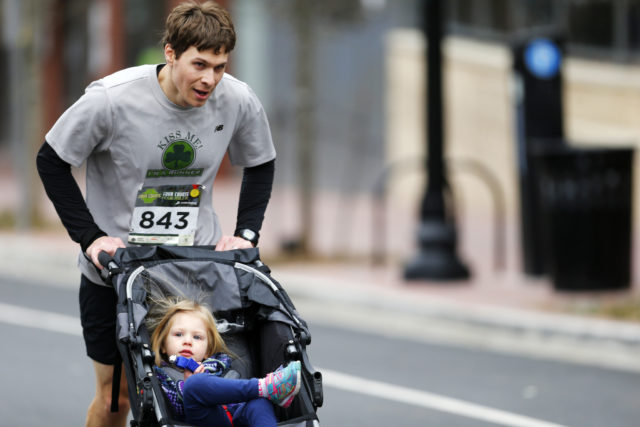
Let’s get something out of the way early: There’s nothing wrong with people passed by a running pushing a stroller.
When Alexandria’s Matias Palavecino breezes by with Leo or Chloe in their BOB, know its an Ironman world championships qualifier getting in a little resistance work. He and young Leo trounced the competition several times at the Patent and Trademark Office Society Innovation 5k.
At last year’s Alexandria Turkey Trot 5 Miler, he finished fourth in his age group with a time of 28:43 and earned himself a first-place finish in the stroller category.
Meanwhile, former Alexandria resident Emily Potter did most of her training for the Olympic Marathon Trials while pushing a double stroller.
So just because they’re running for two, or three, that’s no reason to discount them, or, race directors, listen up, relegate them to the back.
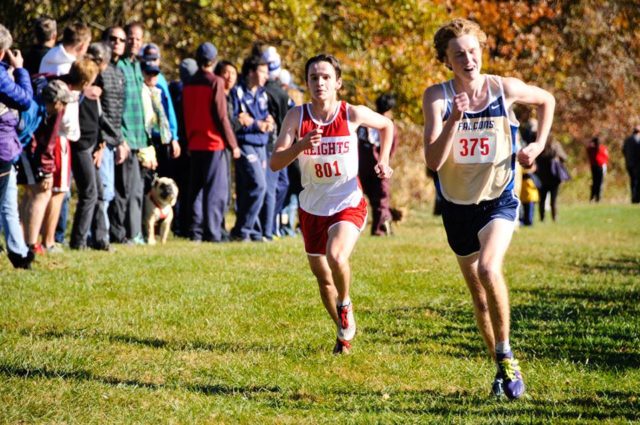
For the second consecutive year, Dalton Hengst of McDonogh nabbed the top spot in the varsity large school race at the Maryland-D.C. Private Schools Cross Country Championships. But this time, it was far from the neck-and-neck race to the finish he experienced last year. He blew away the competition, running 15:29 — a full 44 seconds ahead of second-place finisher Hunter Petrik, of Mount Saint Joseph (16:14), and a 20-second PR over his time last year.
D.C.-Maryland Private School Championships
Nov. 12, 2016 – Agricultural History Farm Park, Derwood, Md.
“I definitely went a lot faster than I thought I was going for the first mile — 4:40 was a little too fast for this course,” Hengst said. “But it was a big mental game out there. That was the hardest part.”
Rounding out the top three in the varsity boys large school race were Petrik and Alex Whittaker, both of Mount Saint Joseph, who finished in 16:14 and 16:24, respectively. Overall, the Mount Saint Joseph boys grabbed four of the top 10 finishes, earning a first-place finish in the team competition. They were followed by Our Lady of Good Counsel, Sidwell Friends, St. Albans and, in fifth place, Georgetown Day.
In the varsity girls large school race, National Cathedral junior Page Lester took an early lead within the first few hundred meters and held on throughout the rolling, 3.1-mile course. When she crossed the finish line in 17:59 — course record time — there were no other runners in sight. This was her second first-place finish in just seven days after winning the DCSAA Championships last weekend in Kenilworth Park.
“Over my high school career, this is my sixth time doing [the Derwood, Maryland course]. I’m used to it,” Lester said, adding that she noticed the absence of Megan Lynch, a freshman at Georgetown Visitation, which, along with Gonzaga, did not compete in both championships. “[We] usually go out in the first mile and a half, but they weren’t here today. So I wasn’t really sure if there would be someone to go out with me.”
Lester opted to start the race at a conservative pace — a relatively new strategy for her, but one that has been paying off this season. Her closest competitors,
Genevieve DiBari and Isabel Barnidge , both of Stone Ridge, finished in second and third place with times of 19:31 and 19:45, respectively.
Senior William Jones, of St. Maria Goretti, finished first (15:58) in the varsity boys small school race and second overall, just 29 seconds behind Hengst.
“I felt pretty good. I made sure I sprinted out to get in front of the crowds so I didn’t get boxed in, and I just tried to stay in the lead as long as I could,” Jones said. “I kept looking at [Hengst]. I just tried closing the gap. I just hammered hard.”
Luke Armbruster (16:37) of St. Andrew’s Episcopal took second in the varsity boys small school competition, followed by The Heights senior Matthew Zischkau (16:44). Overall, The Heights took home first in the team competition, with Lions Upper School in second and St. Andrew’s Episcopal in third.
Several of the Sidwell Friends seniors were thrilled with the way they ended the season.
“We’ve had a pretty strong pack this year. When we run together, we really push each other hard. So it’s good to run that way,” said Amal Mattoo.
Christian Roberts said the team’s strategy for the end-of-season race was to “have fun.”
“It’s always one of the harder races,” he said. “There are big schools like Mount Saint Joseph and Good Counsel — teams we don’t see a lot. It’s the end of the season when we come together and have fun being competitive.”

Push-rim wheelchair racers and handcyclists are familiar on the courses of D.C.-area races, but that’s not the case elsewhere in the country.
For as long as Army Capt. Kelly Elmlinger can remember, running has been a part of her life and of her family’s. Three years ago, the competitive runner was vying for a Boston qualifying time — and missed it by mere minutes. It was a blow, but she was young and certainly would have another shot.
Just a few months later, in March 2013, Elmlinger learned she had synovial sarcoma, a rare soft-tissue tumor, in her lower left leg. While she avoided amputation, the nine surgeries that followed left her without function in her leg. It was difficult to walk, let alone continue to run competitively.
After three deployments to Iraq and Afghanistan, she began caring for wounded warriors as a nurse on the orthopedic unit at Brooke Army Medical Center in San Antonio, and knew her competitive life was not over.
While her cancer diagnosis was devastating, getting back on the road and track as a push rim athlete was bittersweet. In a short time, she’s become an accomplished wheelchair athlete, earning gold medals in the 100m and 400m women’s wheelchair races at the 2014 Invictus Games in London. And she won four silver medals as the only woman to compete in last year’s Warrior Games held at Marine Corps Base Quantico in Quantico, Va.
Earlier this year, the fierce competitor set her eyes on a second shot at qualifying for Boston.
“I’ve always been a person that always has some type of athletic goal,” Elmlinger said. “My thought was, ‘I’m going for it and I’m going for it in the chair.’”
Elmlinger qualified by more than 10 minutes after her third-place finish in the women’s push rim division at the 2015 LA Marathon — her first in a wheelchair. This fall, she traveled to D.C. from her home in San Antonio to compete in the 2015 Army Ten-Miler’s push rim division.
“I wish other people could experience what I’ve been able to,” Elmlinger said, adding that she considers herself lucky to live in a community that has a strong Paralympic and adaptive sports scene. Still, it’s often difficult to find races that will allow her to participate. That’s why she comes to Washington.
At races across the D.C. area, wheeled athletes — both push-rim wheelchair racers and handcyclists — are a common sight. For roughly 20 years, two of Washington’s biggest races, the Marine Corps Marathon (MCM) and the Army Ten-Miler (ATM), have welcomed wheeled athletes with open arms.
But elsewhere across the country, these competitive athletes have fought to be included in the local race scene. Tami Faram, public relations coordinator for the Marine Corps Marathon, explained that because handcycles have gears and brakes, they’re considered bicycles and fall under the jurisdiction of USA Cycling — so many marathons don’t allow them.
In fact, USA Track & Field (USATF) sanctions only allow for a push rim division “provided the wheelchair (push rim) race is done as a separate division or course from the running event,” according to USA TF spokeswoman Jill Geer. Handcycles aren’t even allowed.
“Handcycles are not covered in our area of oversight or insurance,” Greer explained, adding that handcycles are a “different category of equipment.”
Logistically, wheeled divisions require additional planning, something not all race organizers seem to want to do. For starters, handcycles are much faster than push rim wheelchairs and in some cases blaze through the course so quickly that they easily can outrun street closures — a huge liability. A recent case against the Missoula Marathon in Montana found reasonable cause that race organizers discriminated against a quadriplegic participant by limiting the number of wheeled athletes to just eight, imposing speed limits and instructing them to yield to runners, among other offenses.
But some more progressive race organizers are changing this thinking, going the extra mile to allow for all wheelchair athletes — regardless of their mode of transportation — to participate.
“With so many wounded veterans from all branches of the U.S. Armed Forces taking up the sport, the MCM allows the wheeled division, which includes both handcyclists and push rim, to continue to participate in ‘The People’s Marathon,’” Faram said.
According to the U.S. Department of Veterans Affairs, there are approximately 4 million “service-connected” disabled veterans living in the U.S., meaning that their disability was a result of “disease or injury incurred or aggravated during active military service.” And while the veteran population has been declining for the last 30 years, advances in medicine have meant that more wounded veterans are able to survive their injuries; therefore, there’s been a rise in disabled veterans.
For many of these vets, endurance sports like running help them with rehabilitation and regaining the confidence they had before their life-altering injuries. Organizations like D.C.-based Paralyzed Veterans of America have been advocating for more races to allow wheeled athletes to compete.
“It is one of Paralyzed Veterans of America’s big initiatives,” says Jody Shiflett, adaptive cycling program consultant at Paralyzed Veterans of America and an Army veteran. “We work closely with race directors who are open to our involvement and suggestions on how to better accommodate more disabled athletes. The Pittsburgh Marathon is one of the latest marathons that has become more open to the growth of wheeled athletes. The Air Force Marathon in Dayton, Ohio, also has a very progressive race management team and wants to include more wheeled athletes in their growth. Too often, race directors are limiting or even stopping the wheeled racers from competing due to liability and cost.”
Elmlinger believes there’s a “big movement” to shed more light on the issue, especially for disabled vets, and she applauds the military for helping advance the cause.
“You look at what happened with Vietnam [vets]. They weren’t treated very well. We have to change some of these things about society to allow these people to live equally,” she said. “We really credit the military for upping the game in adaptive sports. There are a large amount of wounded veterans. We can’t not do anything for these individuals.”
Army Ten-Miler race director Jim Vandak was surprised to hear there are races that don’t allow these divisions. During his 19-year tenure with the event, wheeled athletes have always been included.
“It’s important to the ATM,” Vandak said. “Many of the people … are wounded, single or double amputees that are still in the Army or they are veterans. The amount of courage and determination to get out there is an inspiration. They are out there to participate and compete and we applaud that. We welcome them.”
Elmlinger plans to return to Washington over the next few years to compete in the
Marine Corps Marathon and the Rock ‘n’ Roll D.C. Marathon as a push rim athlete.
“Sports really do matter. It doesn’t just make me better — it makes me better for my daughter and makes me better for my friends. It has a trickle-down effect. It doesn’t just end with that person.”

